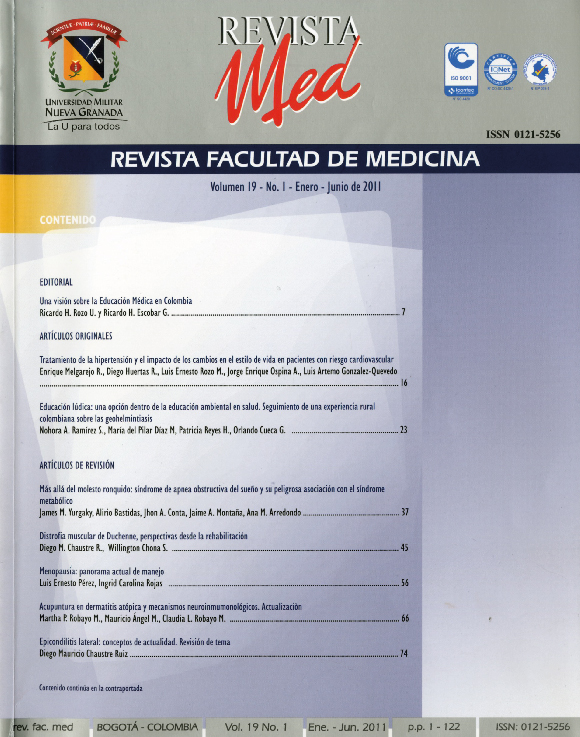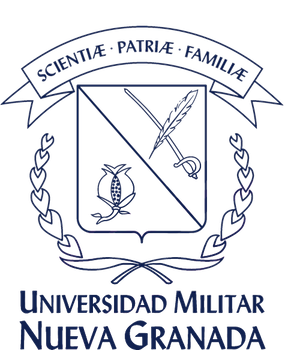Distrofia muscular de Duchenne. Perspectivas desde la rehabilitación
Resumen
La Distrofia Muscular de Duchenne (DMD) es una enfermedad hereditaria de tipo neuromuscular progresiva, que se presenta durante la infancia; afecta aproximadamente 1 de cada 3500 a 6000 niños varones nacidos vivos. El gen DMD que codifica para la distrofina, una proteína estructural del músculo, se localiza en el brazo corto del cromosoma X en la región p21, puede sufrir diferentes mutaciones ocasionando la pérdida parcial o total de la proteína lo que origina la DMD y otras enfermedades relacionadas como la Distrofia Muscular de Becker, que es una distrofia de forma más leve. Esta es una enfermedad discapacitante que se caracteriza por un deterioro progresivo de los músculos, y en las etapas avanzadas de la enfermedad se presentan generalmente complicaciones cardiorespiratorias que son las causas principales que ocasionan la muerte al paciente. Desde el punto de vista de la rehabilitación, cuyo objetivo es retrasar la progresión de la enfermedad, se han venido desarrollado una serie de estrategias de tratamiento y manejo que involucran grupos multidisciplinarios; éstas van desde trabajo en gimnasio con terapeutas para estiramientos hasta prescripción de sillas de ruedas y formulación de ventilación mecánica no invasiva, que si bien se sabe no modifican las bases genéticas de la enfermedad, sí mejoran de forma importante la independencia del paciente, facilitan los cuidados por parte de la familia y los cuidadores y permiten una mejor calidad de vida.Descargas
Lenguajes:
esReferencias bibliográficas
Cammarata-Scalisi F, Camacho N. Distrofia Muscular de Duchenne, presentación clínica. Rev Chil Pediatr. 2008;79(5):495-501.
Tsao C Y, Mendell J R: Coexisting muscular dystrophies and epilepsy in children. J Child Neurol. 2006;21:148-50.
Bushby K, Finkel R. Diagnosis and management of Duchenne muscular dystrophy, part 1: diagnosis, and pharmacological and psychosocial management. Lancet Neurol. 2010;9:77-93.
López-Hernández L, Vázquez-Cárdenas N. Distrofia muscular de Duchenne: actualidad y perspectivas de tratamiento. Rev Neurol. 2009;49(7):369-75.
Bushby KM, Hill A, Steele J G. Failure of early diagnosis in symptomatic Duchenne muscular dystrophy. Lancet. 1999;353:55-78.
Darras B T, Menache C C, Kunkel L M. Dystrophinopathies. In: Jones HR, DeVivo DC, Darras BT, eds. Neuromuscular Disorders of Infancy, Childhood, and Adolescence—A Clinician’s Approach. Amsterdam: Butterworth Heinemann. 2003:649-700.
Meryon E. On granular and fatty degeneration of the voluntary muscles. Medico-Chirurgical Transactions. 1852;35:73-84.
Duchenne GBA. Recherches sur la paralysiemusculairepseudohypertrophiqueouparalysiemyo-sclérosique. Archives Générales de Médecine 1868; 11:5–25, 179–209, 305–321, 421–443, 552–588.
Chamberlain J, Rando T. Duchenne Muscular Distrophy, Advances in Therapeutics. Taylor and Francis Group. New York, 2006.
Hoffman E P, Brown R H Jr, Kunkel L M. Dystrophin: the protein product of the Duchenne muscular dystrophy locus. Cell. 1987;51:919-28.
Davies KE, Nowak KJ. Molecular mechanisms of muscular dystrophies: old and new players. Nat Rev Mol Cell Biol. 2006;7:762-73.
Deconinck N, Dan B. Pathophysiology of Duchenne muscular dystrophy: current hypotheses. Pediatr Neurol. 2007;36:1-7.
Erazo-Torricelli R. Actualización en distrofias musculares. Rev Neurol. 2004;39:860-71.
Labarque V, Freson K. Increased Gssignalling in platelets and impaired collagen activation, due to a defect in the dystrophin gene, result in increased blood loss during spinal surgery. Hum Mol Genet. 2008;17:357-66.
Ciafaloni E, Fox D J, Pandya S. Delayed diagnosis in Duchenne muscular dystrophy: data from the Muscular Dystrophy Surveillance, Tracking, and Research Network (MD STARnet). J Pediatr. 2009;155:380-5.
Darras BT, Menache CC. Neuromuscular Disorders of Infancy, Childhood, and Adolescence—A Clinician’s Approach. Amsterdam: Butterworth Heinemann. 2003:649-700.
Biggar WD. Duchenne muscular dystrophy. Pediatr Rev. 2006;27:83-8. 18. Hoffman E P. Dystrophinopathies. In: Karpati G, Hilton-Jones D, Griggs RC, eds. Disorders of Voluntary Muscle. Cambridge: Cambridge University Press, 2001:385–482.
Brooke MH, Fenichel GM, Griggs RC, et al. Duchenne muscular dystrophy: patterns of clinical progression and effects of supportive therapy. Neurology. 1989;39(4):475-81.
Finder JCCP. Respiratory care of the patient with Duchenne muscular dystrophy: an official ATS consensus statement. Am J Respir Crit Care Med. 2004;170(4):456-65.
Phillips M F, Quinlivan R C, Edwards R H, Calverley P M. Changes in spirometry over time as a prognostic marker in patients with Duchenne muscular dystrophy. Am J Respir Crit Care Med. 2001;164:2191-4.
Bensen E S, Jaffe K M, Tarr P I. Acute gastric dilatation in Duchenne muscular dystrophy: a case report and review of the literature. Arch Phys Med Rehabil. 1996;77(5):512-4.
Boland B J, Silbert P L, Groover R V, Wollan P C, Silverstein M D. Skeletal, cardiac, and smooth muscle failure in Duchenne muscular dystrophy. Pediatr Neurol. 1996;14(1):7-12.
Verma S, Anziska Y. Review of Duchenne Muscular Dystrophy (DMD) for the Pediatricians in the Community. Clinical Pediatrics XX(X) 1–7. 2010.
González-Herrera L, Gamas-Trujillo P A. Identificación de deleciones en el gen de la distrofina y detección de portadoras en familias con distrofia muscular de Duchenne/Becker. Rev Neurol. 2009;48:66-70.
Hornyak J, Pangilinan P. Rehabilitation of Children and Adults Who Have Neuromuscular Diseases. Phys Med Rehabil Clin N Am. 2007;18:883-97.
Bushby K, Finkel R. Diagnosis and management of Duchenne muscular dystrophy, part 2: implementation of multidisciplinary care. Lancet Neurol. 2010;9:177-89.
Jansen M, De Groot M. Physical training in boys with Duchenne Muscular Dystrophy: the protocol of the No Use is Disuse study. Jansen et al. BMC Pediatrics 2010; 10:55.
Hornyak JE 4th, Pangilinan PH Jr. Rehabilitation of children and adults who have neuromuscular diseases. Phys Med Rehabil Clin N Am. 2007;18:883-97.
Bushby K, Finkel R, Birnkrant D J, Case L E, Clemens P, Cripe L. Diagnosis and management of Duchenne muscular dystrophy, part 2: implementation of multidisciplinary care. The Lancet Neurology. 2010;9(2):177-89.
Jansen et al. Physical training in boys with duchenne muscular dystrophy: the protocol of the no use is disuse study. BMC pediatrics. 2010. • texto online: http://www.biomedcentral.com/1471-2431/10/55
Mannlein J, Pangilinan P. Wheelchair seating for children with Duchenne muscular dystrophy , journal of pediatric rehabilitation medicine: an interdisciplinary approach. 2008;1(3):225-35.
Duchenne muscular dystrophy Advances in therapeutics; published in 2006 by taylor&francis group , 270 madison avenue, new york, ny 10016
Mcdonald C M, Carter G, Fowler W et al. Profiles of neuromuscular diseases. Duchenne muscular dystrophy. Am J Phys Med Rehabil. 1995;74:70-92.
Bar-or O, Rowland TW: Neuromuscular and musculoskeletal diseases. In Pediatric Exercise Medicine From Physiologic Principles to Health Care Application. Edited by: Bar-or O, Rowland W. Human Kinetics; 2004:269-303.
Akeson W, Amiel D, Abel M, Garfin S, Woo S. Effects of immobilization on joints. Clinical Orthopaedics and Related Research. 1987;219:28–37.
Booth F W. Physiologic and biochemical effects of immobilization on muscle. Clinical orthopaedics and related research. 1987;219:15-9.
Colliandereb T. Effects of detraining following short term resistance training on eccentric and concentric muscle strength. Acta Physiol Scand. 1992;144:23-9.
Hainaut K, Duchateau J. Muscle fatigue, effects of training and disuse. Muscle & Nerve. 1989;12:660-9.
Kottkef J. The effects of limitation of activity upon the human body. JAMA. 1966;196:117-22.
Muller E A. Influence of training and of inactivity on muscle strength. Arch Phys Med Rehabil. 1970;51:449-62.
Robinson G A, Stuart D G. Immobilization-induced changes in motor unit force and fatigability in the cat. Muscle & Nerve. 1991;14:563-73.
Bach J, Mckeon J. Orthopedic surgery and rehabilitation for the prolongation of bracefree ambulation of patients with Duchenne muscular dystrophy. American Journal of Physical Medicine and Rehabilitation. 1991;70:323-31.
Fowler W M. Rehabilitation management of muscular dystrophy and related disorders: i. The role of exercise. Arch Phys Med Rehabil. 1982;63:319-21.
Gardner-medwin D. Management of muscular dystrophy. Physiotherapy. 1977;63:46-55.
Harris S E, Cherry D B. Childhood progressive muscular dystrophy and the role of physical therapy. Physical Therapy. 1974;54:4-12.
Brooke M H, Fenichel G M, Griggs R C et al. Duchenne muscular dystrophy: patterns of clinical progression and effects of supportive therapy. Neurology. 1989;39:475-81.
Johnson E W, Walter J. Zeiter lecture: pathokinesiology of Duchenne muscular dystrophy: implications for management. Arch Phys Med Rehabil. 1977;58:4-7.
Sutherland D H, Olshen R, Cooper l, et al. The pathomechanics of gait in duchenne muscular dystrophy. Dev Med Child Neurol. 1981;23:3-22.
Archibald K C, Vignosp J. A study of contractures in muscular dystrophy. Arch phys med rehabil. 1959;40:150-57.
Johnson E R, Fowler W, Lieberman J. Contractures in neuromuscular disease. Arch Phys Med Rehabil. 1992;73:807-10.
Hsu J D, Furumasu J. Gait and posture changes in the Duchenne muscular dystrophy child. Clin Orthop Relat Res. 1993;288:122-25.
Dubowitz V. Progressive muscular dystrophy: prevention of deformities. Clin Pediatr. 1964;12:323-8.
Dubowitz V. Prevention of deformities. Isr J Med Sci. 1977;13:183-8.
Vignosp J. Physical models of rehabilitation in neuromuscular disease. Muscle & Nerve. 1983;6:323-38.
Siegel I M, Weiss L A. Postural substitution in duchenne’s muscular dystrophy. JAMA. 1982;247:584.
Owler W. Rehabilitation management of muscular dystrophy and related disorders. Comprehensive care. Arch Phys Med Rehabil. 1982;63:322-8.
Hyde S A, Fløytrup I, Glent S et al. A randomized comparative study of two methods for controlling tendoachilles contracture in Duchenne muscular dystrophy. Neuro Muscul Disord. 2000;10:257-63.
Johnson E W, Kennedy J. Comprehensive management of Duchenne muscular dystrophy. Arch Phys Med Rehabil. 1971;52:110-14.
Eagle M, Baudouin S V, Chandler C, Giddings D, Bullock R, Bushby K. Survival in duchenne muscular dystrophy: improvements in lifeexpectancy since 1967 and the impact of home nocturnal ventilation. Neuro Muscul Disord. 2002;12:926-9.
Jones D A, Rutheford O. Human muscle strength training: the effects of three different regimes and the nature of the resultant changes. J Physiol. 1987;391:1-11.
Edstrom L, Grimby L. Effect of exercise on the motor unit. Muscle & Nerve. 1986;9:104-26.
Alway S E, Macdougall J, Sale D et al. Functional and structural adaptations in skeletal muscle of trained athletes. J Appl Physiol. 1988;64:1114-20.
Cote C, Simoneau J, Lagasse P et al. Isokinetic strength training protocols: do they show 132induce skeletal muscle fiber hypertrophy? Arch Phys Med Rehabil. 1988;69:281-5.
Herbison G et al. Exercise of normal muscle: biochemical effects. Arch Phys Med Rehabil. 1973;54:409-15.
Luthi J, Howald H, Claassen H et al. Structural changes in skeletal muscle tissue with heavyresistance exercise. Int J Sports Med. 1986;7:123-7.
Adams M A, Chandler L. Effects of physical therapy program on vital capacity of patients with muscular dystrophy. Physical Therapy. 1974;54:494-6.
Hortobagyi T, Katch F. Role of concentric force in limiting improvement in muscular strength. J Appl Physiol. 1990;68:650-8.
Holloszy J. Muscle metabolism during exercise. Arch Phys Med Rehabil. 1982;63:231-4.
Sockolov R, Irwin B, Dressendorfer R, Fowler W. Exercise performance in 6 to 11 year old boys with duchenne muscular dystrophy. Arch Phys Med Rehabil. 1977;58:195-201.
Bennett R, Knowlton G. Overwork weakness in partially denervated skeletal. Muscle Clin Orthop. 1958;22-9.
Balnave C, Thompson M. Effect of training on eccentric exerciseinduced muscle damage. J Appl Physiol. 1993;75:1545-51.
Clarkson P, Kazuno R, Braun B. Muscle function after exerciseinduced muscle damage and rapid adaptation. Med Sci Sports Exerc. 1992;24:512-20.
Duchateau J, Hainaut K. Isometric or dynamic training: differential effects on mechanical properties of a human muscle. J Appl Physiol. 1984;56:296-301.
Hather B, Tesch P, Buchanan P et al. Influence of eccentric actions on skeletal muscle adaptations to resistance training. Acta Physiol Scand. 1991;143:177-85.
Byrd S K. Alterations in the sarcoplasmic reticulum: a possible link to exercise-induced muscle damage. Med Sci Sports Exerc. 1992;24:531-6.
Clarkson P, byrneswc, mccormick km, et al. Muscle soreness and serum creatine kinase activity following isometric, eccentric, and concentric exercise. Int J Sports Med. 1986;7:152-7.
Clarkson P, Tremblay I. Exercise-induced muscle damage, repair, and adaptation in humans. J Appl Physiol. 1988;65:1-6.
Friden j, lieberrl. Structural and mechanical basis of exercise-induced muscle injury. Med sci sports exerc 1992;24:521–30.
Leiber R, Friden J. Muscle damage is not a function of muscle force but active muscle strain. J Appl Physiol. 1993;74:520-6.
Mccully K, Shellock F, Bank W et al. The use of nuclear magnetic resonance to evaluate muscle injury. Med Sci Sports Exerc. 1992;24:537-42.
Mcneil P, Khakee R. Disruptions of muscle fiber plasma membranes: role of exerciseinduced damage. Am J Path. 1992;140:1097-109.
Sacco P, Jones D, Dickjrt et al. Contractile properties and susceptibility to exercise-induced damage of normal and mdx mouse tibialis anterior muscle. Clin Sci. 1992;82:227-36.
Carter G, Kikuchi N, Abresch R, Walsh S, Horasek S, Fowler W. Effects of exhaustive concentric and eccentric exercise on murine skeletal muscle. Arch Phys Med Rehab. 1994;75(5):555-9.
Carter G, Wineinger M, Walsh S, Horasek S, Fowler W. Effect of voluntary wheel-running exercise on muscles of the mdx mouse. Neuro muscul disord. 1995;5(4):323-31.
Aitkens S, Mccrory M, Kilmerd D et al. Moderate resistance exercise program: its effect in slowly progressive neuromuscular disease. Arch Phys Med Rehabil. 1993;74:711-5.
Bohannon R, Jones P. Results of manual resistance exercise on a manifesting carrier of duchenne muscular dystrophy: A case report. Phys Ther. 1986;66:973-5.
Delateur B, Giaconi R. Effect on maximal strength of submaximal exercise in duchenne muscular dystrophy. Am J Phys Med. 1979;58:26-36.
Dimarco A F, Kelling J S, Dimarco M et al. The effects of inspiratory resistive training on respiratory muscle function in patients with muscular dystrophy. Muscle & Nerve. 1985;8(4):284-90.
Dupont-versteegden E, Mccarter R, Katz M. Voluntary exercise decreases progression of muscular dystrophy in diaphragm of mdx mice. J Appl Physiol. 1994;77:1736-41.
Dscalante A, Miller L, Beardmore T. Resistive exercise in the rehabilitation of polymyositis/ dermatomyositis. J Rheum. 1993;20:1340-4.
Florence J, Hagberg J M. Effect of training on the exercise responses of neuromuscular disease patients. Med Sci Sports Exerc. 1984;5:460-5.
Hicks J, Miller F, Plotz P, et al. Isometric exercise increases strength and does not produce sustained creatinine phosphokinase increases in a patient with polymyositis. J Rheu. 1993;20:1399-401.
Kawazoe Y, Kobayashi M, Tasaka T et al. Effects of therapeutic exercise on masticatory function in patients with progressive muscular dystrophy. J Neurol Neurosurg Psychiatry. 1982;45:343-7.
Kilmer D, Mccrory M, Wright N et al. The effect of high resistance exercise program in slowly progressive neuromuscular disease. Arch Phys Med Rehabil. 1994;75:560-3.
Iohi E, Lindber C, Andersen O. Physical training effects in myasthenia gravis. Arch Phys Med Rehabil. 1993;74:1178-80.
Mccartney N, Moroz D, Garner S et al. The effects of strength training in show 132 patients with selected neuromuscular disorders. Med Sci Sports Exerc. 1988;20:362-8.
Milner-brown H, Miller R. Muscle strengthening through highresistance weight training in patients with neuromuscular diseases. Arch Phys Med Rehabil. 1988;69:14-9.
Martin R, Sufit R, Ringle S et al. Respiratory improvement by muscle training in adultonset acid maltase deficiency. Muscle & Nerve. 1983;6:201-3.
Scott O, Hyde S, Goddard C et al. Effect of exercise in Duchenne muscular dystrophy. Physiotherapy. 1981;67:174-6.
Spector S, gordonpl, et al. Strength gains without muscle injury after strength training with postpolio muscular atrophy. Muscle & Nerve. 1996;19:1282-90.
Spector S, Lemmer J, Koffman B et al. Safety and efficacy of strength training in show 132 patients with sporadic inclusion body myositis. Muscle & Nerve. 1997;20:1242-8.
Taylor R, Fowler W, Doerr l. Exercise effect on contractile properties of skeletal muscle in mouse muscular dystrophy. Arch Phys Med Rehabil. 1976;57:174-80.
Vignos P, Watkins M. The effect of exercise in muscular dystrophy. JAMA. 1966;197:121-6.
Webster C, Silberstein L, Hays A, Blau H. Fast muscle fibers are preferentially affected in duchenne muscular dystrophy. Cell. 1988;52(4):503-13.
Tardieu C, Lespargot A, Tabary C et al. For how long must the soleus muscle be stretched each day to prevent contracture? Developmental medicine and child neurology. 1988;30:3-10.
Cusick B. Splints and casts: managing foot deformity in children with neuromotor disorders. Physic Ther. 1988;68:1903-12.
Bar-or O. Role of exercise in the assessment and management of neuromuscular disease in Children. Med Sci Sports Exerc. 1995;28:421-7.
Edwardsr H. Studies of muscular performance in normal and dystrophic subjects. Brit Med Bull. 1980;36:159-64.
Haller R, Lewis S. Pathophysiology of exercise performance in muscle disease. Med Sci Sports Exerc. 1984;16:456-9.
Lewis S. Exercise and human neuromuscular diseases: a symposium overview. Med Sci Sports Exerc. 1984;16:449-50.
Wright N, Kilmer D, Mccrory M et al. Aerobic walking in slowly progressive neuromuscular Disease: effect of a 12-week program. Arch Phys Med Rehabil. 1996;77:64-9.
American college of sports medicine. In: guidelines for exercise testing and prescription. 4th ed. Philadelphia: lea & febiger; 1991. Páginas 11-32.
Mcdonald C M, Widman L, Walsh D, Walsh S, Abresch R. Use of step activity monitoring for continuous physical activity assessment in boys with duchenne muscular dystrophy. Arch Phys Med Rehabil. 2005;86:802-8.
Carter G T, Abresch R, Fowler W. Adaptations to exercise training and contraction-induced muscle injury in animal models of neuromuscular disease. Am J Phys Med Rehabil. 2002;81:151-161.
Lim J, Kim D, Bang M. Effects of exercise and steroid on skeletal muscle apoptosis in the mdx mouse. Muscle & Nerve. 2004;30:456-62.
Bush B. The multidisciplinary management of duchennemuscular dystrophy, Curr Pediat. 2005;15(4):292–300.
Pellegrini N, Guillon B, Prigent H et al., optimization ofpower wheelchair control for patients with severe duchennemuscular dystrophy, Neuro Muscul Disord. 2004;14(15):297-300.
Clark J, Michael S, Morrow M. Wheel chair postural support For young people with progressive neuromuscular disorders. Int J Therapy Rehabil. 2004;11(8)365–373.
Engstrom E D. Ergonomics, wheelchairs and positioning, Sweden: brommatryck, ab; 1993
Bakker J, de Groot I J, Beelen A, Iankhorst G. Predictive factors of cessation of ambulation in patients with duchenne muscular dystrophy, Am J Phys Med Rehabil. 2002;81(12):906-12.
Guerette P, Tefft D, Furumasu J. Pediatric powered wheelchairs: results of a national survey of providers. Assist Technol. 2005;17(2):144-58.
Mcdonald C. Limb contractures in progressive neuromuscular disease and the role of stretching, orthotics, and surgery. Phys Med Rehabil Clin N Am. 1998;9:187-211.
Siegel I. Plastic-molded knee-ankle-foot orthoses in the treatment of duchenne muscular dystrophy. Arch Phys Med Rehabil. 1975;56:322.
Bakker J, de Grooti J, de Jong B et al. Prescription pattern for orthoses in the netherlands: use and experience in the ambulatory phase of duchenne muscular dystrophy. Disabil Rehabil. 1997;19:318-25.







.png)





